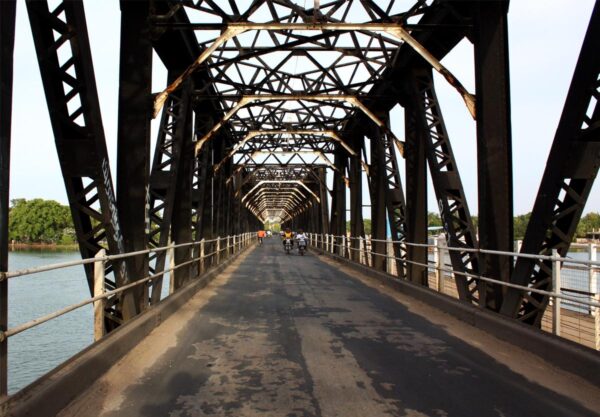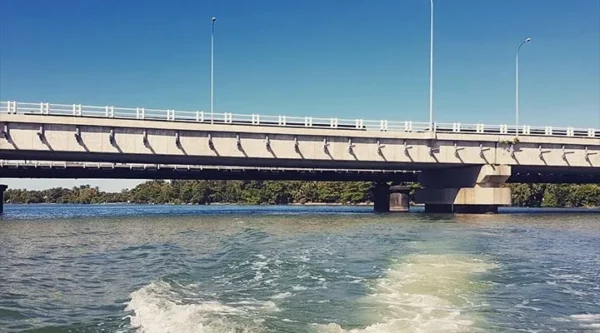Kallady Bridge in the land of “Singing Fish” – By Arundathie Abeysinghe

Kallady Bridge, Batticaloa (inside view)
 Prefabricated in 1924 in the United Kingdom and imported to Sri Lanka, Kallady Bridge was the longest iron bridge in Sri Lanka in the past. Kallady Bridge connects *Kallady to *Batticaloa and it is a unique bridge shrouded in history and legend. The Bridge is officially known as “Lady Manning Bridge” and was named to honor Lady Manning, the wife of the former Governor of *Ceylon William Manning. The view from the Bridge is spectacular and serene…
Prefabricated in 1924 in the United Kingdom and imported to Sri Lanka, Kallady Bridge was the longest iron bridge in Sri Lanka in the past. Kallady Bridge connects *Kallady to *Batticaloa and it is a unique bridge shrouded in history and legend. The Bridge is officially known as “Lady Manning Bridge” and was named to honor Lady Manning, the wife of the former Governor of *Ceylon William Manning. The view from the Bridge is spectacular and serene…
The massive truss bridge had been prefabricated at Patent Shaft & Axletree and transported by steamship from London. During that period, it had been a challenge for engineers to set up the Bridge over the flowing waters of the Lagoon. Although, it has been constructed in 1924, it has been installed 1928.
Constructed during the British Colonial Era, the Bridge served as the main route for around 100 years. Approximately 10,000 vehicles crossed the narrow single lane rail bridge, daily. Due to large numbers of vehicles utilizing the narrow bridge, there had been many accidents which lead to traffic congestion for several hours.
Hence, in 2013, local authorities decided to construct a wider bridge parallel to the old bridge as a post-war development project, to replace the original bridge to accommodate more vehicles. At present, the old bridge is utilized by pedestrians and cyclists.
Kallady Bridge crosses the Batticaloa Lagoon and is part of the Colombo-Batticaloa Highway (A4). The Bridge has 6 spans, connected by 54 precast post-tensioned box girders, each with a length of 48 meters and a weight of 180 tons.
According to locals and tourists, an enthralling sound emanates under the Bridge popularly known as “Singing Fish” by locals and tourists, considered as a maritime mystery, a harmonious sound emanating from the depths of the *Batticaloa Lagoon. Although, many locals and tourists have visited the location to find out the reason regarding the melodious sound of “Singing Fish”, there is no conclusive evidence regarding this. Hence, the Bridge is a major attraction to local and foreign tourists who want to witness a unique natural phenomenon. Some tourists consider it as a mystery, whereas the majority are curious to probe in-depth and research about it.
According to some locals, the musical sound rising from the water can be heard better on full moon nights. Hence, the site is full of tourists on full moon nights. Locals are of the view that to hear this music well, one must travel by boat under the Bridge, stop below it and dip the oar into water and hold the other end to one’s ear.
Hence, Batticaloa is also known as the “Land of the Singing Fish.”
Scholars are of the view that the melodious sound emanates from the activity of the marine ecosystem near the Bridge.
At the end of the new bridge, on the right side of the road, there is another remarkable cement structure which displays a large fish swimming gracefully with four orange hued fish mounted on a blue circular pond, considered as a reminder of Batticaloa’s “Singing Fish” anecdote.
According to scholars, in 1954, two American presets from St. Michael’s College, Batticaloa, Rev. Fr. Lang and Rev. Fr. Moran recorded fish singing under Kallady Bridge. The recording has been broadcasted on *Radio Ceylon in 1960s.

A popular local artist Gunadasa Kapuge sings the song “Kallady Palama Pamula” depicting ethnic harmony which also mentions Kallady Bridge.
Tips
Walk along the Bridge at night to listen to the “Singing Fish.”
The best period to hear music is between April and September.
Vehicles are strictly prohibited from travelling on the original Iron Bridge.
Image courtesy – traveladventures.org & maga.lk
- Batticaloa – A major town and commercial center in the Eastern Province of Sri Lanka, Batticaloa is located on land between Batticaloa Lagoon and the Indian Ocean, Batticaloa District is flourished with three lagoons, *Batticaloa Lagoon, Valaichchenai Lagoon and Vakari Lagoon.
- Batticaloa Lagoon – A very large estuarine lagoon in Batticaloa District in eastern Sri Lanka. Batticaloa Lagoon is the largest lagoon among the three lagoons in Batticaloa District. A long and narrow lagoon situated in the east coast of Sri Lanka with the total area of approximately 11,500 hectares of water. The Lagoon is 56 kilometers long and extends from Eravur in Batticaloa District in the north to Kalmunai in Ampara District in the south. A densely populated region utilized for cultivating rice, coconut and several other crops and fed by several small rivers, it is linked to the sea by two narrow channels, one at Batticaloa and the other at Periyakallar. During the dry season, these channels are blocked by sand bars. The Lagoon has extensive mangrove swamps and some sea grass beds. The lagoon attracts a wide variety of aquatic birds.
- Ceylon – Sri Lanka gained Independence from British Colonials in 1948. In 1972, Ceylon became a republic within the Commonwealth and Ceylon was thereafter known as Sri Lanka.
- Governor William Manning – Brigadier-General Sir William Henry Manning, GCMG, KBE, CB (1863 – 1932) was a British Indian Army officer and colonial administrator. Educated at the University of Cambridge as a non-collegiate student and the Royal Military College, Sandhurst, he was appointed Governor of Ceylon, in September, 1918.
- Kallady – A village in Batticaloa District of Eastern province of Sri Lanka situated north of Batticaloa.
- Radio Ceylon – A radio station based in Sri Lanka (formerly Ceylon) and the first radio station in Asia, broadcasting had been commenced at Radio Ceylon on an experimental basis by the colonial Telegraph Department in 1923, three years after the inauguration of broadcasting in Europe. History of Radio Ceylon dates to 1925, when its first precursor, Colombo Radio has been launched on December 16, 1925, utilizing a mediumwave radio transmitter of one kilowatt of output power from Welikada in Colombo. Commenced three years after the launch of BBC, Colombo Radio was the first radio station in Asia and the second oldest radio station in the world. This new medium of mass communication became increasingly popular and evolved into a medium of national character, which led to the “Radio Service” being organized as a separate department of the Government of Ceylon (currently Sri Lanka), in 1949. At present, Radio Ceylon is known as Sri Lanka Broadcasting Corporation (SLBC).







